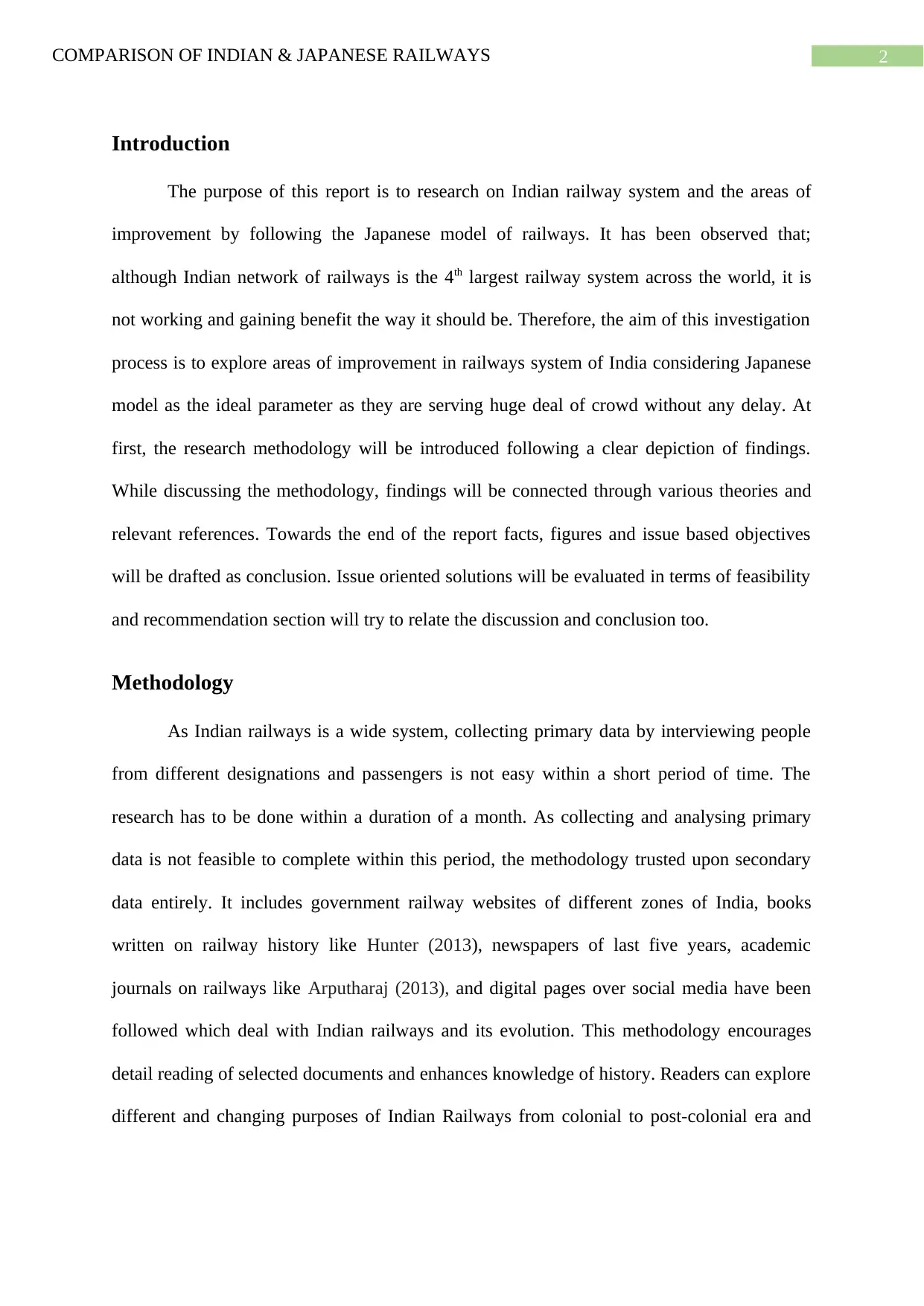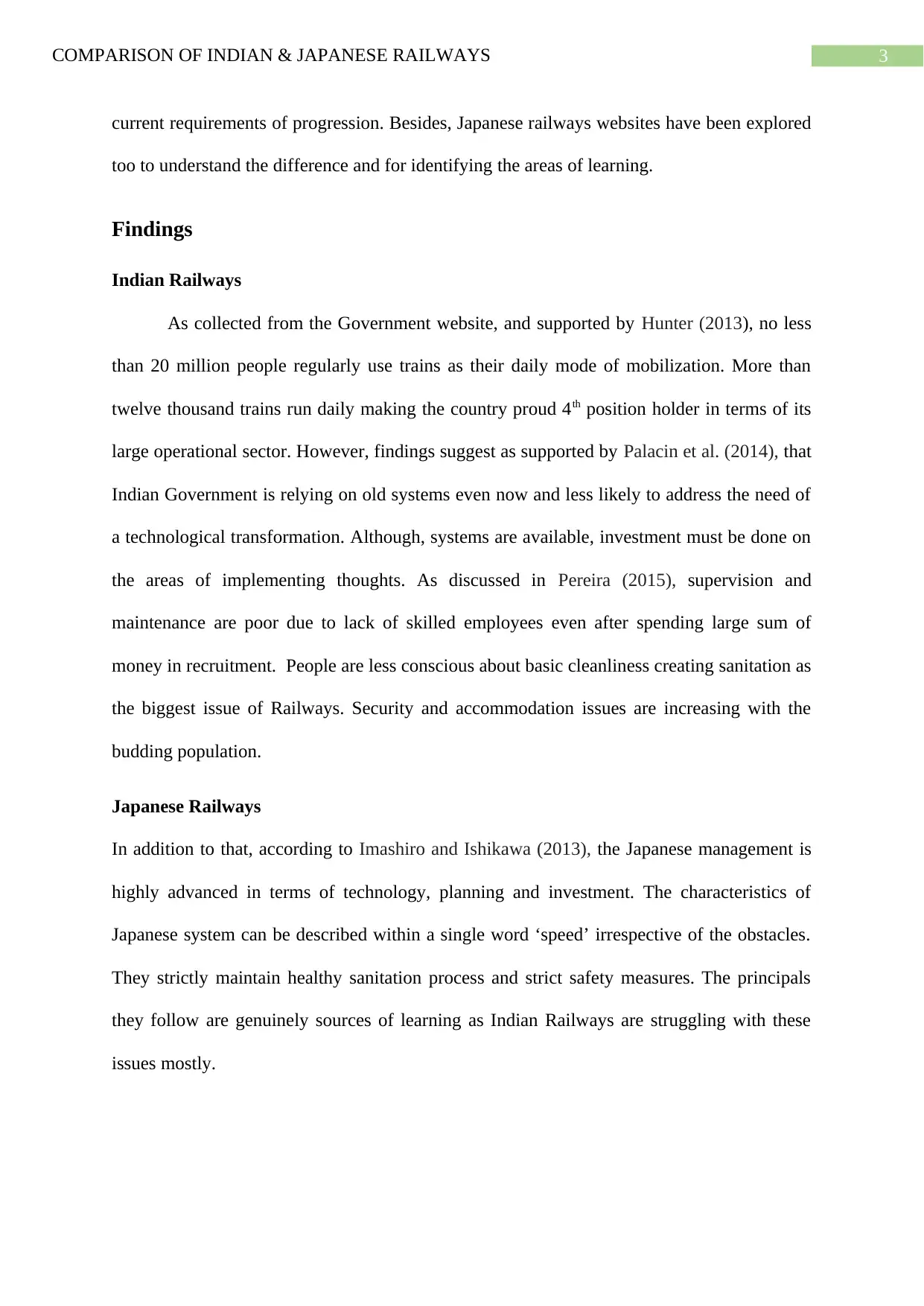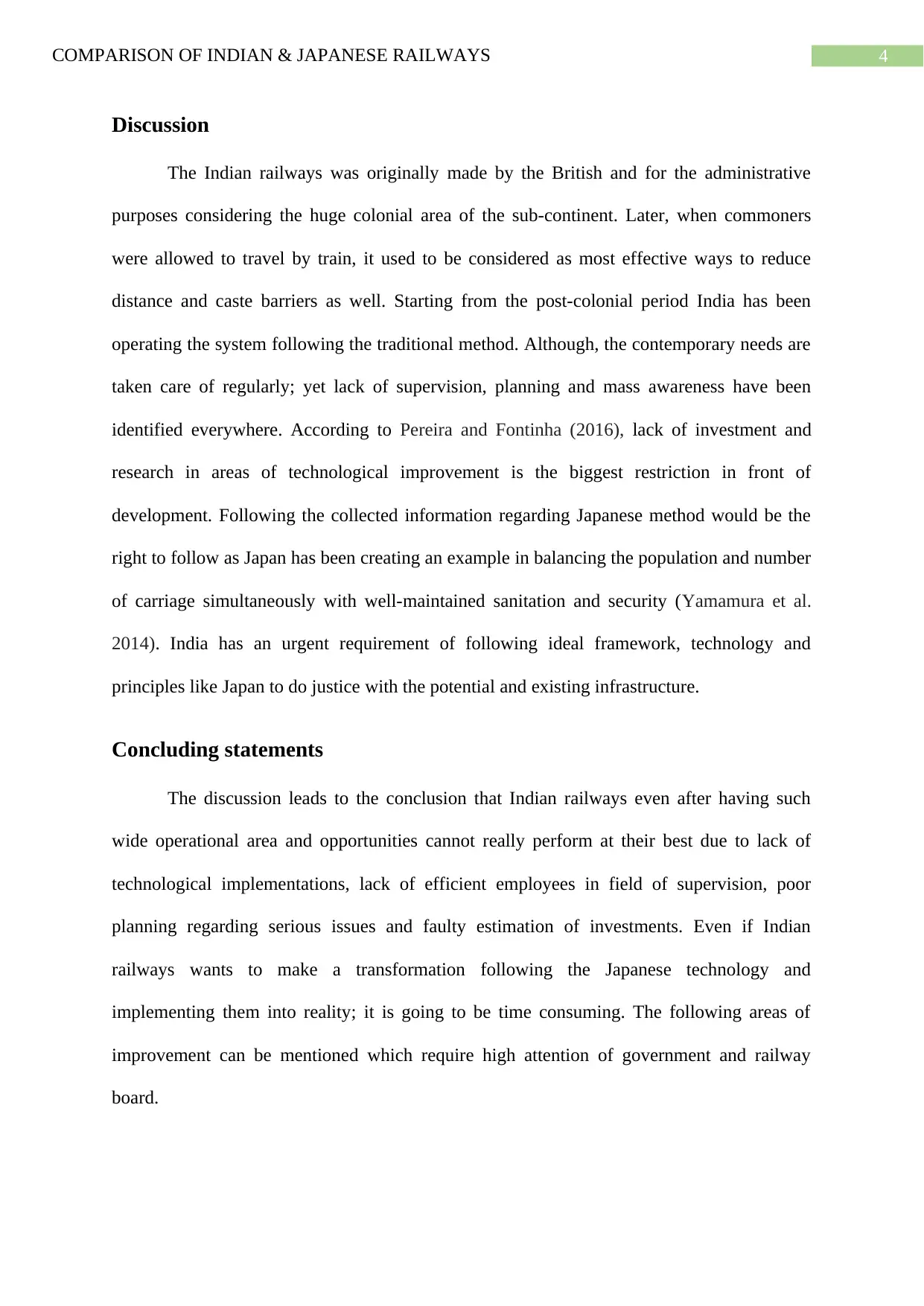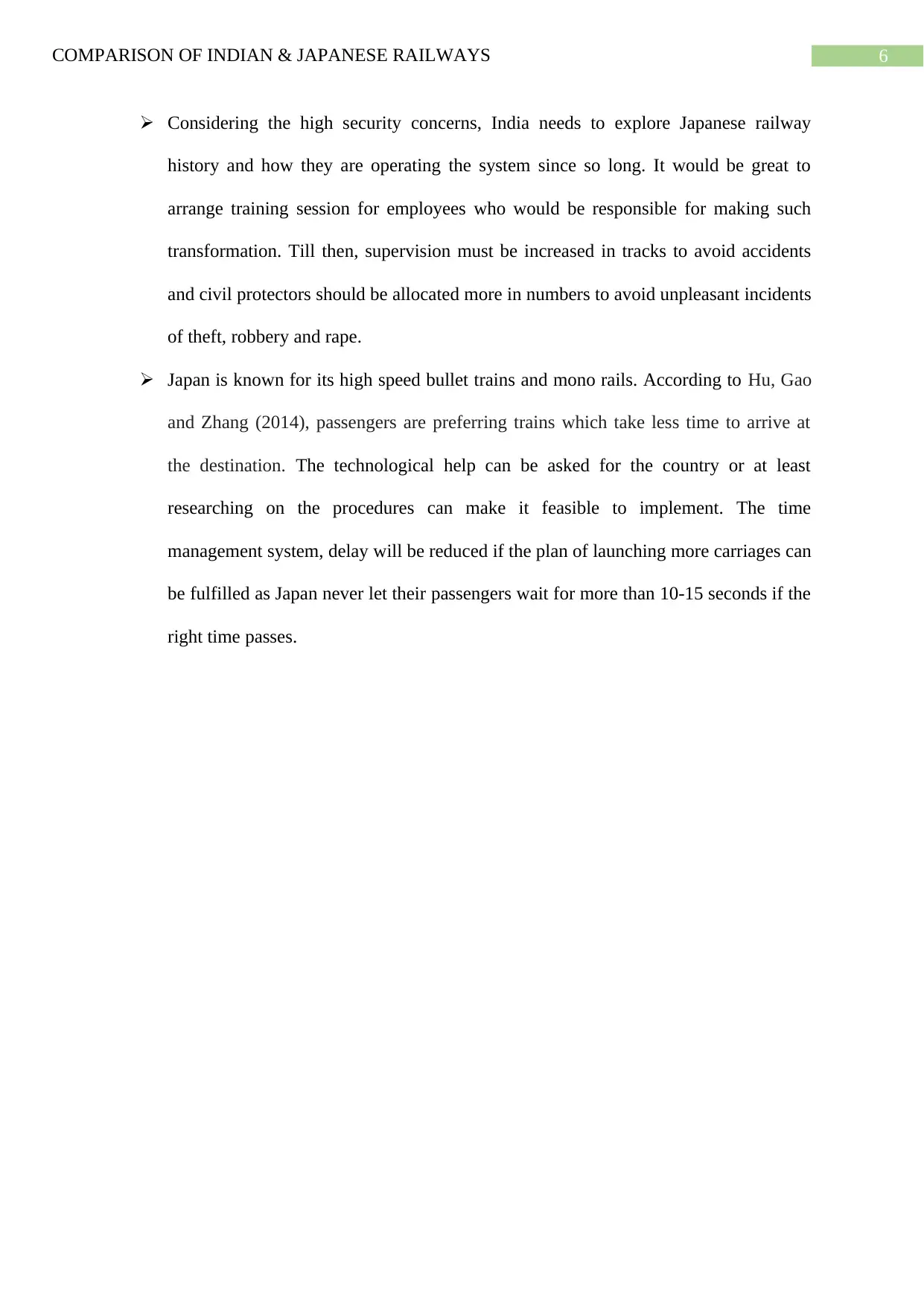Comparative Study: Indian and Japanese Railway Systems - Economics
VerifiedAdded on 2023/04/26
|8
|1760
|153
Report
AI Summary
This report provides a comparative analysis of the Indian and Japanese railway systems, focusing on areas for potential improvement in the Indian system by drawing parallels with the Japanese model. The report begins with an introduction outlining the research's purpose and scope, followed by a description of the secondary data-driven methodology employed, which includes an analysis of government websites, historical texts, academic journals, and social media. The findings section presents key differences in the operational efficiency, technological integration, and passenger experience between the two railway systems. The discussion section delves into the historical context, operational challenges, and the impact of technological advancements, emphasizing the importance of investment, planning, and public awareness. Concluding statements summarize the shortcomings of the Indian railway system and highlight specific areas needing attention, such as infrastructure, sanitation, and security. The report recommends improvements like increased investment, implementation of cleanliness campaigns, and adoption of Japanese railway technologies. The references section lists all sources used in the research.

Running head: COMPARISON OF INDIAN & JAPANESE RAILWAYS
Comparison of Indian & Japanese Railways
Name of the university
Name of the student
Author note
Comparison of Indian & Japanese Railways
Name of the university
Name of the student
Author note
Paraphrase This Document
Need a fresh take? Get an instant paraphrase of this document with our AI Paraphraser

1COMPARISON OF INDIAN & JAPANESE RAILWAYS
Table of Contents
Introduction....................................................................................................................2
Methodology..................................................................................................................2
Findings..........................................................................................................................3
Indian Railways..........................................................................................................3
Japanese Railways......................................................................................................3
Discussion......................................................................................................................3
Concluding statements...................................................................................................4
Recommendations..........................................................................................................5
References......................................................................................................................7
Table of Contents
Introduction....................................................................................................................2
Methodology..................................................................................................................2
Findings..........................................................................................................................3
Indian Railways..........................................................................................................3
Japanese Railways......................................................................................................3
Discussion......................................................................................................................3
Concluding statements...................................................................................................4
Recommendations..........................................................................................................5
References......................................................................................................................7

2COMPARISON OF INDIAN & JAPANESE RAILWAYS
Introduction
The purpose of this report is to research on Indian railway system and the areas of
improvement by following the Japanese model of railways. It has been observed that;
although Indian network of railways is the 4th largest railway system across the world, it is
not working and gaining benefit the way it should be. Therefore, the aim of this investigation
process is to explore areas of improvement in railways system of India considering Japanese
model as the ideal parameter as they are serving huge deal of crowd without any delay. At
first, the research methodology will be introduced following a clear depiction of findings.
While discussing the methodology, findings will be connected through various theories and
relevant references. Towards the end of the report facts, figures and issue based objectives
will be drafted as conclusion. Issue oriented solutions will be evaluated in terms of feasibility
and recommendation section will try to relate the discussion and conclusion too.
Methodology
As Indian railways is a wide system, collecting primary data by interviewing people
from different designations and passengers is not easy within a short period of time. The
research has to be done within a duration of a month. As collecting and analysing primary
data is not feasible to complete within this period, the methodology trusted upon secondary
data entirely. It includes government railway websites of different zones of India, books
written on railway history like Hunter (2013), newspapers of last five years, academic
journals on railways like Arputharaj (2013), and digital pages over social media have been
followed which deal with Indian railways and its evolution. This methodology encourages
detail reading of selected documents and enhances knowledge of history. Readers can explore
different and changing purposes of Indian Railways from colonial to post-colonial era and
Introduction
The purpose of this report is to research on Indian railway system and the areas of
improvement by following the Japanese model of railways. It has been observed that;
although Indian network of railways is the 4th largest railway system across the world, it is
not working and gaining benefit the way it should be. Therefore, the aim of this investigation
process is to explore areas of improvement in railways system of India considering Japanese
model as the ideal parameter as they are serving huge deal of crowd without any delay. At
first, the research methodology will be introduced following a clear depiction of findings.
While discussing the methodology, findings will be connected through various theories and
relevant references. Towards the end of the report facts, figures and issue based objectives
will be drafted as conclusion. Issue oriented solutions will be evaluated in terms of feasibility
and recommendation section will try to relate the discussion and conclusion too.
Methodology
As Indian railways is a wide system, collecting primary data by interviewing people
from different designations and passengers is not easy within a short period of time. The
research has to be done within a duration of a month. As collecting and analysing primary
data is not feasible to complete within this period, the methodology trusted upon secondary
data entirely. It includes government railway websites of different zones of India, books
written on railway history like Hunter (2013), newspapers of last five years, academic
journals on railways like Arputharaj (2013), and digital pages over social media have been
followed which deal with Indian railways and its evolution. This methodology encourages
detail reading of selected documents and enhances knowledge of history. Readers can explore
different and changing purposes of Indian Railways from colonial to post-colonial era and
⊘ This is a preview!⊘
Do you want full access?
Subscribe today to unlock all pages.

Trusted by 1+ million students worldwide

3COMPARISON OF INDIAN & JAPANESE RAILWAYS
current requirements of progression. Besides, Japanese railways websites have been explored
too to understand the difference and for identifying the areas of learning.
Findings
Indian Railways
As collected from the Government website, and supported by Hunter (2013), no less
than 20 million people regularly use trains as their daily mode of mobilization. More than
twelve thousand trains run daily making the country proud 4th position holder in terms of its
large operational sector. However, findings suggest as supported by Palacin et al. (2014), that
Indian Government is relying on old systems even now and less likely to address the need of
a technological transformation. Although, systems are available, investment must be done on
the areas of implementing thoughts. As discussed in Pereira (2015), supervision and
maintenance are poor due to lack of skilled employees even after spending large sum of
money in recruitment. People are less conscious about basic cleanliness creating sanitation as
the biggest issue of Railways. Security and accommodation issues are increasing with the
budding population.
Japanese Railways
In addition to that, according to Imashiro and Ishikawa (2013), the Japanese management is
highly advanced in terms of technology, planning and investment. The characteristics of
Japanese system can be described within a single word ‘speed’ irrespective of the obstacles.
They strictly maintain healthy sanitation process and strict safety measures. The principals
they follow are genuinely sources of learning as Indian Railways are struggling with these
issues mostly.
current requirements of progression. Besides, Japanese railways websites have been explored
too to understand the difference and for identifying the areas of learning.
Findings
Indian Railways
As collected from the Government website, and supported by Hunter (2013), no less
than 20 million people regularly use trains as their daily mode of mobilization. More than
twelve thousand trains run daily making the country proud 4th position holder in terms of its
large operational sector. However, findings suggest as supported by Palacin et al. (2014), that
Indian Government is relying on old systems even now and less likely to address the need of
a technological transformation. Although, systems are available, investment must be done on
the areas of implementing thoughts. As discussed in Pereira (2015), supervision and
maintenance are poor due to lack of skilled employees even after spending large sum of
money in recruitment. People are less conscious about basic cleanliness creating sanitation as
the biggest issue of Railways. Security and accommodation issues are increasing with the
budding population.
Japanese Railways
In addition to that, according to Imashiro and Ishikawa (2013), the Japanese management is
highly advanced in terms of technology, planning and investment. The characteristics of
Japanese system can be described within a single word ‘speed’ irrespective of the obstacles.
They strictly maintain healthy sanitation process and strict safety measures. The principals
they follow are genuinely sources of learning as Indian Railways are struggling with these
issues mostly.
Paraphrase This Document
Need a fresh take? Get an instant paraphrase of this document with our AI Paraphraser

4COMPARISON OF INDIAN & JAPANESE RAILWAYS
Discussion
The Indian railways was originally made by the British and for the administrative
purposes considering the huge colonial area of the sub-continent. Later, when commoners
were allowed to travel by train, it used to be considered as most effective ways to reduce
distance and caste barriers as well. Starting from the post-colonial period India has been
operating the system following the traditional method. Although, the contemporary needs are
taken care of regularly; yet lack of supervision, planning and mass awareness have been
identified everywhere. According to Pereira and Fontinha (2016), lack of investment and
research in areas of technological improvement is the biggest restriction in front of
development. Following the collected information regarding Japanese method would be the
right to follow as Japan has been creating an example in balancing the population and number
of carriage simultaneously with well-maintained sanitation and security (Yamamura et al.
2014). India has an urgent requirement of following ideal framework, technology and
principles like Japan to do justice with the potential and existing infrastructure.
Concluding statements
The discussion leads to the conclusion that Indian railways even after having such
wide operational area and opportunities cannot really perform at their best due to lack of
technological implementations, lack of efficient employees in field of supervision, poor
planning regarding serious issues and faulty estimation of investments. Even if Indian
railways wants to make a transformation following the Japanese technology and
implementing them into reality; it is going to be time consuming. The following areas of
improvement can be mentioned which require high attention of government and railway
board.
Discussion
The Indian railways was originally made by the British and for the administrative
purposes considering the huge colonial area of the sub-continent. Later, when commoners
were allowed to travel by train, it used to be considered as most effective ways to reduce
distance and caste barriers as well. Starting from the post-colonial period India has been
operating the system following the traditional method. Although, the contemporary needs are
taken care of regularly; yet lack of supervision, planning and mass awareness have been
identified everywhere. According to Pereira and Fontinha (2016), lack of investment and
research in areas of technological improvement is the biggest restriction in front of
development. Following the collected information regarding Japanese method would be the
right to follow as Japan has been creating an example in balancing the population and number
of carriage simultaneously with well-maintained sanitation and security (Yamamura et al.
2014). India has an urgent requirement of following ideal framework, technology and
principles like Japan to do justice with the potential and existing infrastructure.
Concluding statements
The discussion leads to the conclusion that Indian railways even after having such
wide operational area and opportunities cannot really perform at their best due to lack of
technological implementations, lack of efficient employees in field of supervision, poor
planning regarding serious issues and faulty estimation of investments. Even if Indian
railways wants to make a transformation following the Japanese technology and
implementing them into reality; it is going to be time consuming. The following areas of
improvement can be mentioned which require high attention of government and railway
board.

5COMPARISON OF INDIAN & JAPANESE RAILWAYS
Increasing the number of carriages as per recent report regarding the number of daily
passengers and ever expanded population of India. Investments must be made for
building more rotes and tracks to avoid excessive pressure over the current system.
Although, junctions have been provided with free internet for communication
purposes, toilets are not cleaned properly or people lack civic sense to maintain the
cleanliness.
There are various busiest stations which are not equipped with escalators and lifts for
senior citizens, persons carrying heavy baggage and physically disabled people.
There are lack of women security and general security as well in express trains
particularly at second class compartments.
Railway must renew the proposals for enacting a change addressing all the
problematic areas where investments should be done.
Recommendations
Considering the nature of issues following recommendations can be made which has
been organised serially in terms of significance for the welfare of Indians who depends upon
Indian Railway for regular mobilization.
Campaigns must be conducted in favour of cleanliness ventures and strict fine system
must be allocated to for leaving a railway toilet in unhygienic way. In case, India
wants to follow luxury railway toilets like Japan, investment would be huge to
redesigning infrastructure. Moreover, people need to travel in local trains up to three
to four hours without having facilities of water and toilet. It is difficult for women, old
people and sick persons to travel like this. Considering the fact small lavatory can be
installed in local trains too along with advanced equipment like escalators and lifts.
Increasing the number of carriages as per recent report regarding the number of daily
passengers and ever expanded population of India. Investments must be made for
building more rotes and tracks to avoid excessive pressure over the current system.
Although, junctions have been provided with free internet for communication
purposes, toilets are not cleaned properly or people lack civic sense to maintain the
cleanliness.
There are various busiest stations which are not equipped with escalators and lifts for
senior citizens, persons carrying heavy baggage and physically disabled people.
There are lack of women security and general security as well in express trains
particularly at second class compartments.
Railway must renew the proposals for enacting a change addressing all the
problematic areas where investments should be done.
Recommendations
Considering the nature of issues following recommendations can be made which has
been organised serially in terms of significance for the welfare of Indians who depends upon
Indian Railway for regular mobilization.
Campaigns must be conducted in favour of cleanliness ventures and strict fine system
must be allocated to for leaving a railway toilet in unhygienic way. In case, India
wants to follow luxury railway toilets like Japan, investment would be huge to
redesigning infrastructure. Moreover, people need to travel in local trains up to three
to four hours without having facilities of water and toilet. It is difficult for women, old
people and sick persons to travel like this. Considering the fact small lavatory can be
installed in local trains too along with advanced equipment like escalators and lifts.
⊘ This is a preview!⊘
Do you want full access?
Subscribe today to unlock all pages.

Trusted by 1+ million students worldwide

6COMPARISON OF INDIAN & JAPANESE RAILWAYS
Considering the high security concerns, India needs to explore Japanese railway
history and how they are operating the system since so long. It would be great to
arrange training session for employees who would be responsible for making such
transformation. Till then, supervision must be increased in tracks to avoid accidents
and civil protectors should be allocated more in numbers to avoid unpleasant incidents
of theft, robbery and rape.
Japan is known for its high speed bullet trains and mono rails. According to Hu, Gao
and Zhang (2014), passengers are preferring trains which take less time to arrive at
the destination. The technological help can be asked for the country or at least
researching on the procedures can make it feasible to implement. The time
management system, delay will be reduced if the plan of launching more carriages can
be fulfilled as Japan never let their passengers wait for more than 10-15 seconds if the
right time passes.
Considering the high security concerns, India needs to explore Japanese railway
history and how they are operating the system since so long. It would be great to
arrange training session for employees who would be responsible for making such
transformation. Till then, supervision must be increased in tracks to avoid accidents
and civil protectors should be allocated more in numbers to avoid unpleasant incidents
of theft, robbery and rape.
Japan is known for its high speed bullet trains and mono rails. According to Hu, Gao
and Zhang (2014), passengers are preferring trains which take less time to arrive at
the destination. The technological help can be asked for the country or at least
researching on the procedures can make it feasible to implement. The time
management system, delay will be reduced if the plan of launching more carriages can
be fulfilled as Japan never let their passengers wait for more than 10-15 seconds if the
right time passes.
Paraphrase This Document
Need a fresh take? Get an instant paraphrase of this document with our AI Paraphraser

7COMPARISON OF INDIAN & JAPANESE RAILWAYS
References
Arputharaj, A. N. (2013). Case study on performance management system in Indian
railway. Prestige International Journal of Management & IT-Sanchayan, 2(1), 127.
Hu, Q., Gao, N., & Zhang, B. (2014). High speed railway environment safety evaluation
based on measurement attribute recognition model. Computational intelligence and
neuroscience, 2014, 25.
Hunter, W. W. (2013). The Indian empire: Its people, history and products. Routledge.
Imashiro, M., & Ishikawa, T. (2013). The privatisation of Japanese national railways:
railway management, market and policy. A&C Black.
Palacin, R., Raif, L., Deniz, O., & Yan, N. (2014). High speed rail trends, technologies and
operational patterns: a comparison of established and emerging networks. Transport
problems, 9(spec.), 123-129.
Pereira, V. (2015). Managing people in the world's largest commercial employer: an
exploratory study on Indian Railways. International Journal of Indian Culture and
Business Management, 10(2), 136-156.
Pereira, V., & Fontinha, R. (2016). An exploration of the role duality experienced by HR
professionals as both implementers and recipients of HR practices: evidence from the
Indian railways. Human Resource Management, 55(1), 127-142.
Yamamura, A., Koresawa, M., Adachi, S., & Tomii, N. (2014). Taking effective delay
reduction measures and using delay elements as indices for Tokyo’s metropolitan
railways. Comput. Railw. XIV, 135, 3-15.
References
Arputharaj, A. N. (2013). Case study on performance management system in Indian
railway. Prestige International Journal of Management & IT-Sanchayan, 2(1), 127.
Hu, Q., Gao, N., & Zhang, B. (2014). High speed railway environment safety evaluation
based on measurement attribute recognition model. Computational intelligence and
neuroscience, 2014, 25.
Hunter, W. W. (2013). The Indian empire: Its people, history and products. Routledge.
Imashiro, M., & Ishikawa, T. (2013). The privatisation of Japanese national railways:
railway management, market and policy. A&C Black.
Palacin, R., Raif, L., Deniz, O., & Yan, N. (2014). High speed rail trends, technologies and
operational patterns: a comparison of established and emerging networks. Transport
problems, 9(spec.), 123-129.
Pereira, V. (2015). Managing people in the world's largest commercial employer: an
exploratory study on Indian Railways. International Journal of Indian Culture and
Business Management, 10(2), 136-156.
Pereira, V., & Fontinha, R. (2016). An exploration of the role duality experienced by HR
professionals as both implementers and recipients of HR practices: evidence from the
Indian railways. Human Resource Management, 55(1), 127-142.
Yamamura, A., Koresawa, M., Adachi, S., & Tomii, N. (2014). Taking effective delay
reduction measures and using delay elements as indices for Tokyo’s metropolitan
railways. Comput. Railw. XIV, 135, 3-15.
1 out of 8
Your All-in-One AI-Powered Toolkit for Academic Success.
+13062052269
info@desklib.com
Available 24*7 on WhatsApp / Email
![[object Object]](/_next/static/media/star-bottom.7253800d.svg)
Unlock your academic potential
Copyright © 2020–2025 A2Z Services. All Rights Reserved. Developed and managed by ZUCOL.


